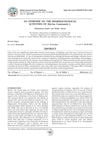Review of Pharmacological Effects of Myrtus Communis L. and Its Active Constituents
February 2014
in “
Phytotherapy Research
”
Myrtus communis myrtle polyphenols essential oils antioxidant antibacterial antifungal antiviral neuroprotective hypoglycemic antidiabetic antiparasitic insecticidal larvicidal molluscicidal repellent gastric ulcers anti-Helicobacter pylori hepatoprotective testosterone cardiovascular dermatological hair growth

TLDR Myrtle has various health benefits and potential for medicine development.
The document from 2014 reviews the pharmacological effects of Myrtus communis L. (myrtle) and its active constituents, which have been traditionally used for various disorders. The review indicates that myrtle contains active compounds such as polyphenols and essential oils that contribute to its antioxidative, anticancer, anti-diabetic, antiviral, antibacterial, antifungal, hepatoprotective, and neuroprotective activities. Myrtle extracts have shown significant antinociceptive activity, antioxidant capacity, neuroprotective effects, antimutagenic properties, and induced apoptosis in cancer cell lines. The extracts also demonstrated hypoglycemic effects in animal models, suggesting anti-diabetic potential. Additionally, myrtle oil treatment in diabetic rabbits improved certain enzyme activities and decreased glucose and triglyceride concentrations. Myrtle has strong antibacterial activity against various bacteria, antifungal activity against Candida albicans and Aspergillus spp., and antiviral effectiveness against HSV-1. It also has anti-parasitic effects against Plasmodium falciparum and Leishmania major, and insecticidal properties. The oil has larvicidal and molluscicidal effects, while the leaf essential oil has repellent effects against disease vectors. Myrtle extracts can protect against gastric ulcers, have anti-Helicobacter pylori activity, protect against hepatic ischemia-reperfusion damage, increase testosterone levels, and have cardiovascular and dermatological benefits, including promoting hair growth. The review concludes that myrtle has potential for pharmaceutical development but emphasizes the need for further research to fully understand its therapeutic potential.



